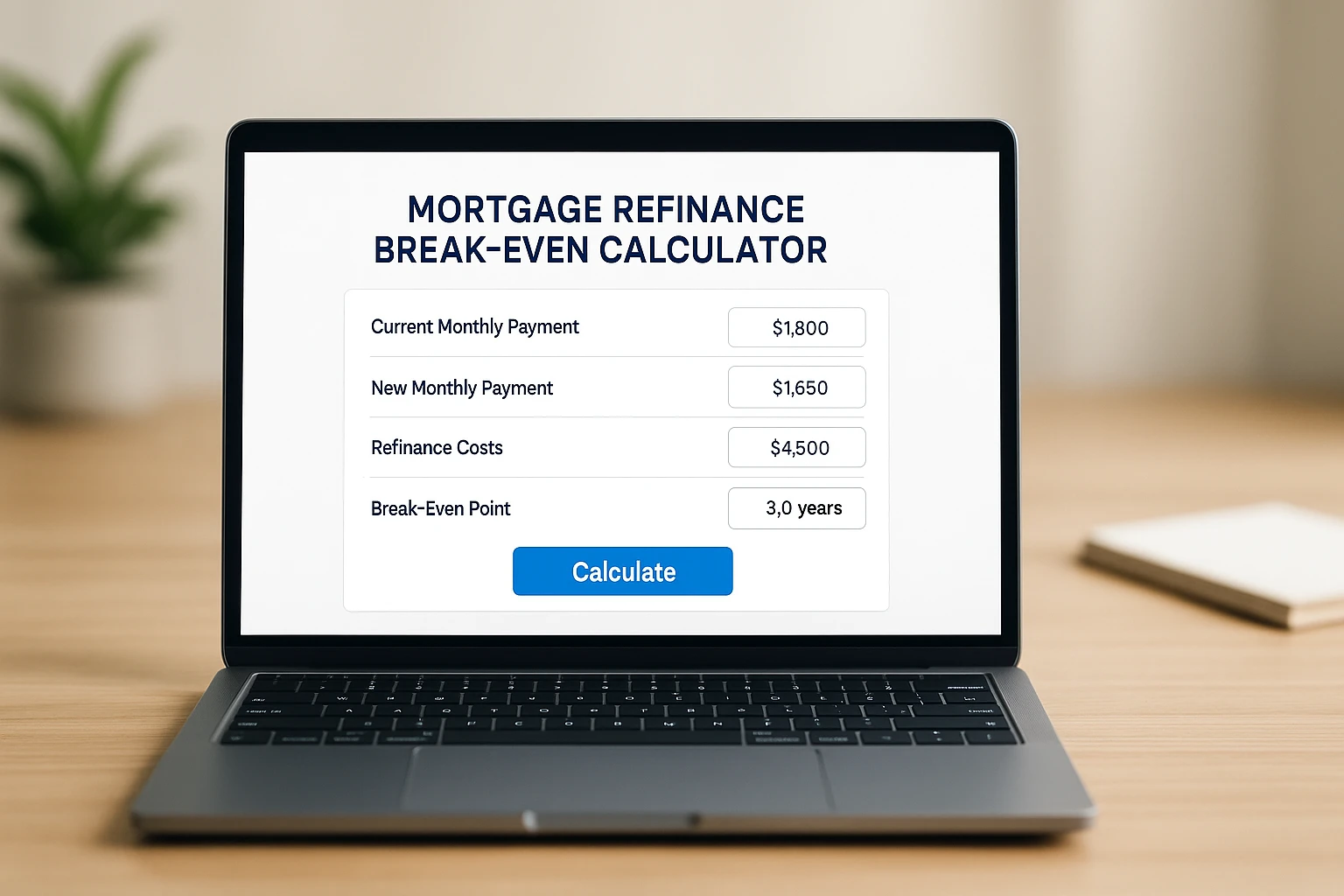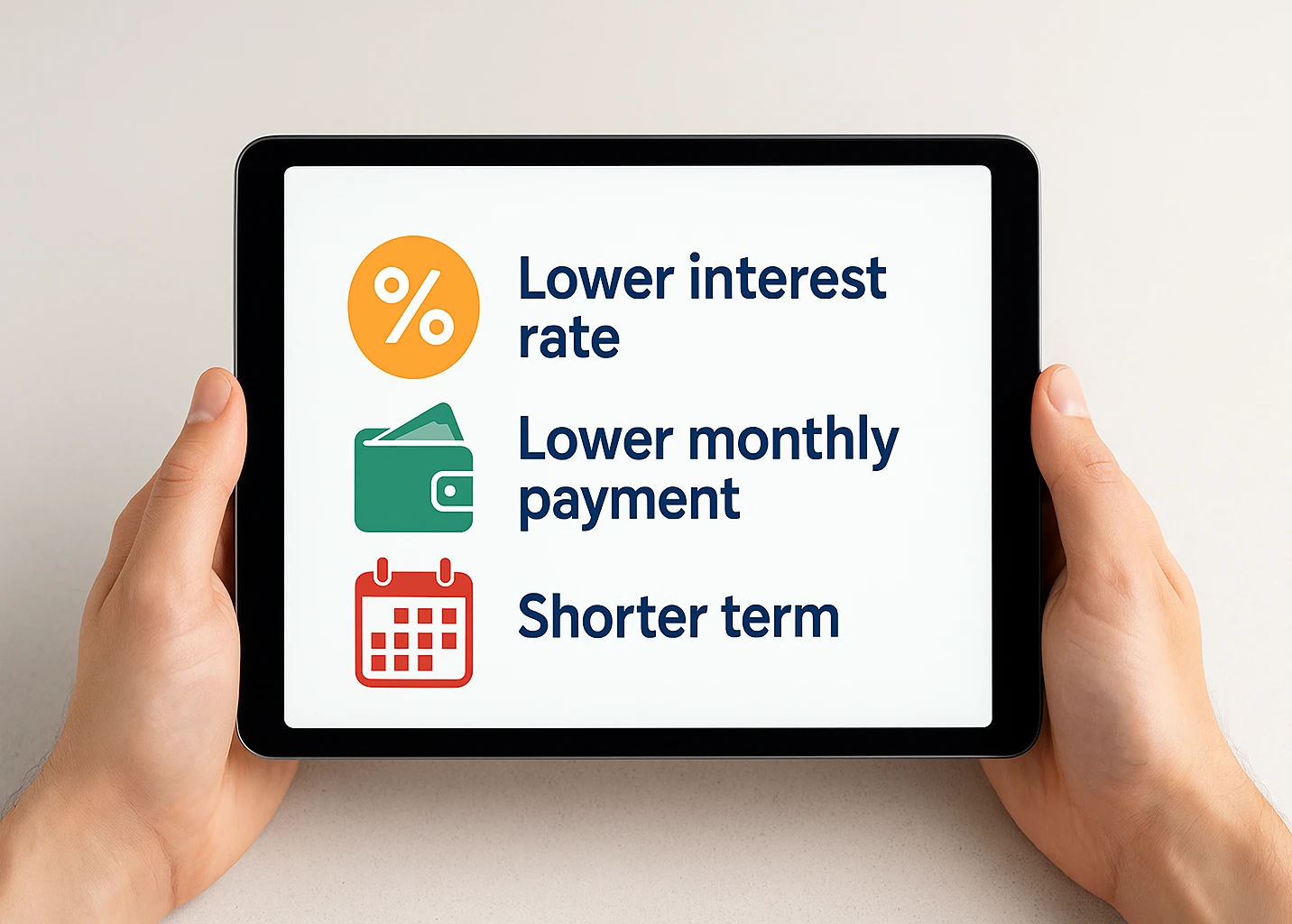
Refinancing could save you $10,000 over your loan term. For many homeowners, it can lower monthly payments—but the key is knowing when you actually come out ahead. This guide shows how to use a mortgage refinance break even calculator to find your break-even point and decide if a refi makes sense, plus smart ways to use any savings.
Curious how much you could save? Try the calculator below.
Calculate Your Savings Now!Table of Contents
- Key Takeaways for Mortgage Refinancing
- What Is Mortgage Refinancing?
- Understanding the Break-Even Point
- How to Use a Mortgage Refinance Break Even Calculator
- Interactive Mortgage Refinance Break Even Calculator
- Is Now a Good Time to Refinance?
- Mortgage Refinance Break Even Calculator: Real-World Scenarios
- Other Factors to Consider
- Using Refinance Savings Wisely
- Tips for a Successful Refinance
- Frequently Asked Questions
- Conclusion
Key Takeaways for Mortgage Refinancing
- Break-Even Point: When monthly savings equal closing costs, that’s when refinancing pays off.
- Break-Even Calculator: Divides costs by savings to show your timeline.
- Benefits: The calculator reveals monthly savings and payoff dynamics without guesswork.
- Timeline Matters: Selling before breaking even may cost you; longer stays maximize savings.
- Other Goals: Refinancing can shorten terms, switch loan types, or access equity.
What Is Mortgage Refinancing?
Refinancing replaces your current home loan with a new one, often with better terms. Most homeowners refinance for lower rates, but there are other compelling reasons. Timing matters—low rates or improved credit can amplify savings. Here’s why refinancing might work for you.
Financial Benefits of Refinancing
Refinancing can improve your financial situation in several ways:
- Lower Interest Rate: Dropped rates mean lower monthly payments.
A lower rate offers instant budget relief.
- Lower Monthly Payment: Extending your term (e.g., 15 to 30 years) frees up cash, but increases total interest.
- Shorter Loan Term: A 15-year term raises payments but saves interest and speeds ownership—try a mortgage payoff calculator to see how to pay off your mortgage faster. 🥳
- Cash-Out Refinance: Tap into your home’s equity to fund home upgrades or pay off high-interest debt.
- Switch Loan Types: Swap an adjustable-rate mortgage (ARM) for a fixed-rate one to lock in predictable payments.
- Remove Mortgage Insurance: If your home has climbed in value, you can drop pricey PMI or MIP.

Understanding the Break-Even Point
The break-even point is your refinancing sweet spot: the moment monthly savings finally cover closing costs. Example: $3,000 in fees with $100 monthly savings = 30 months to break even. After that, savings accrue—$1,200 a year if you stay five years. Ask yourself: Will you stay long enough to benefit?
Your break-even point is a simple way to forecast refinancing rewards.
How to Use a Mortgage Refinance Break Even Calculator
This tool simplifies finding your break-even point. Here’s how:
Step 1: Estimate Closing Costs
Refinancing fees—origination, appraisal, title insurance—typically cost 2%–5% of your loan. For a $300,000 loan, expect $6,000–$15,000. Lenders provide a Loan Estimate within three days. Example: Closing costs are $4,500.
Step 2: Calculate New Payment
Enter your balance, new rate, and term. Example: A $250,000 loan at 3.5% over 30 years might yield a $1,122 payment.
Step 3: Find Monthly Savings
Subtract your new payment from your current one. Example: Current: $1,400; New: $1,122; Savings: $278.
Step 4: Compute Break-Even
Divide costs by savings. Example: $4,500 ÷ $278 = 16.19 months. Stay 17+ months to save.
Interactive Mortgage Refinance Break Even Calculator
Estimate Your Break-Even and Monthly Savings
Enter your loan details to find your break-even point and potential savings.
New Monthly Payment: $0.00
Monthly Savings: $0.00
Break-Even Point: 0 months
Is Now a Good Time to Refinance?
Mortgage rates change with the economy. Compare current quotes to your rate—a 0.5%–0.75% drop can justify refinancing if costs are reasonable. Check lenders or Federal Reserve data for trends.

Mortgage Refinance Break Even Calculator: Real-World Scenarios
Want to see how others saved? Check these examples. 📊 In each case, the calculator clarifies the trade-offs.
Scenario 1: Short-Term Stay
Example: Sarah owes $200,000 at 5% ($1,073/mo). She refinances to 3.75% ($926/mo), saving $147/mo, with $4,000 costs. She’ll sell in two years.
- Break-Even: $4,000 ÷ $147 = 27.2 months.
- Verdict: She won’t break even in 24 months, losing $472. Not ideal.
Scenario 2: Long-Term Stay
Example: Mark and Lisa owe $300,000 at 4.5% ($1,520/mo), staying 15 years. They refinance to a 15-year loan at 3.25% ($2,100/mo), with $5,000 costs.
- Payment Change: Up by $580.
- Interest Savings: Original: $156,000; New: $78,000; Savings: $73,000.
- Verdict: They save $73,000 and pay off 10 years sooner. Great move.
Scenario 3: Cash-Out Refinance
A cash-out refinance borrows more than you owe, giving cash for renovations. Use the calculator for your original principal, then weigh cash benefits against any higher loan costs.
| Scenario | Monthly Savings | Break-Even | Verdict |
|---|---|---|---|
| Short-Term Stay | $147 | 27.2 months | Not ideal if selling soon |
| Long-Term Stay | -$580 | N/A (interest focus) | Great for long-term savings |
| Cash-Out Refinance | Varies | Varies | Weigh cash vs. loan costs |
Other Factors to Consider
Look beyond the break-even point for a smart refinance decision.
Credit Score Impact
A 740+ score gets the best rates. Refinancing may ding your score temporarily, so avoid new credit during the process.
Loan Term Changes
- Shortening Term: Higher payments, less interest, faster payoff.
- Lengthening Term: Lower payments, more interest over time.
Prepayment Penalties
Some loans charge for early payoff. Check terms, as penalties extend break-even time.
Recasting vs. Refinancing
Instead of refinancing, consider mortgage recasting, which lowers payments by re-amortizing your loan after a lump-sum payment. It’s often cheaper but less flexible than refinancing.

Using Refinance Savings Wisely
Your savings can transform your finances. Prioritize goals based on your needs, like debt or retirement. Here’s how to use them:
- Pay Down Debt: Consider debt consolidation to clear high-interest cards and save more.
- Emergency Fund: Save 3–6 months of expenses.
- Retirement Investments: Low-cost index funds can put savings to work.
- Home Improvements: Boost your home’s value.
- Other Goals: Fund education or travel.
Tips for a Successful Refinance
Maximize benefits with these tips:
- Shop and Negotiate: Compare several lenders and haggle fees.
- “No-Cost” Refinances: These often trade higher rates for lower upfront costs—check total interest.
- Review Documents: Verify Loan Estimates for accuracy.
- Prepare Paperwork: Have pay stubs and tax returns ready.
- Monitor Credit: Avoid new credit to keep your score strong.
Frequently Asked Questions
Conclusion
Refinancing can save thousands, but it isn’t automatic. Use a mortgage refinance break even calculator to confirm your break-even month, compare lenders, and weigh costs against the time you’ll stay put. Then put any savings to work.
This content is for informational purposes only and not financial advice. Consult a professional before making financial decisions.

